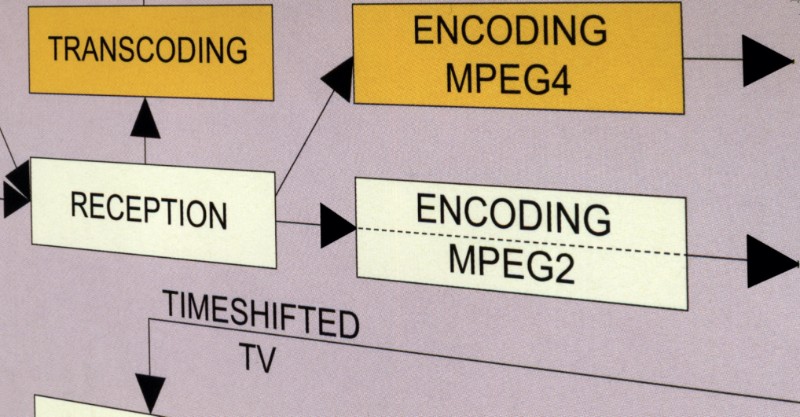Video Streaming Encoding – All You Need to Know
Digital content encoding is a crucial part of preparing video data for streaming. At Bianor, we use advanced encoding techniques to optimize video quality and reduce file size, ensuring smooth and efficient delivery to viewers.

In the lines below, we will cover the following:
- What is encoding?
- Why is encoding important?
- Types of encoding
- Encoding settings
- Adaptive bitrate streaming – overview
- Summary
What is Encoding?
Encoding converts raw data into a specific format easily transmitted over the Internet. In the case of video streaming, encoding involves converting a video file into a compressed format that can be transferred quickly and efficiently over the Internet.
Why is Encoding Important?
Without encoding, video files would be too large to transmit over the internet, making video streaming impossible. Encoding allows for the efficient transmission of video files over the internet, enabling high-quality video streaming experiences for viewers.
Types of encoding
There are two main types of encoding used in video streaming:
- Lossy Encoding – This type of encoding involves compressing video files by removing certain parts of the video data. This process results in a smaller file size, losing some original video data. Examples of lossy encoding include H.264 and MPEG-4.
- Lossless Encoding – This encoding type compresses video files without losing original video data. Lossless encoding results in a larger file size than lossy encoding and preserves the video quality. Examples of lossless encoding include Apple ProRes and Avid DNxHD.
Here’s a table that shows the differences between lossy and lossless encoding, as well as the impact of different encoding settings:
Lossy vs. Lossless Encoding:
| Lossy Encoding | Lossless Encoding | |
| File Size | Smaller | Larger |
| Video Quality | Some data loss | No data loss |
| Compression | Higher | Lower |
| Playback Speed | Faster | Slower |
| Bitrate | Variable | Variable |
| Video Codec | H.264, MPEG-4 | Apple ProRes, DNxHD |
| Multipass Encoding | Yes | Yes |
| Adaptive Bitrate | Yes | Yes |
OR
mail us at info@bianor.com
Encoding Settings
The specific encoding settings used for video encoding can also significantly impact the final output quality. Factors like the resolution, frame rate, and color depth can all affect the overall quality of the video. Streaming providers must carefully choose these settings based on the content they transfer and the devices on which it will be viewed.
When encoding a video, the streaming service provider can adjust several settings to optimize the video for streaming. Some of these settings include:
- Bitrate
- A critical factor in video encoding for streaming is choosing the correct bitrate. It determines the amount of data sent to the viewer’s device per second, thus affecting both the quality of the video and the extent of occurring buffering. The higher the bitrate, the better the quality and the more data the viewer needs to download. Streaming providers must balance the desire for high quality with the need for smooth playback on various devices and network conditions.
- Video Codec
- Another major factor is the video codec used for encoding. Codecs like H.264 and HEVC (H.265) are commonly used for streaming because they offer high compression rates without significant loss of quality. However, newer codecs like AV1 and VVC are emerging that offer even better compression rates, which can help reduce buffering and improve playback quality on devices with limited bandwidth.
- Multipass Encoding
- Many streaming providers use multi-pass encoding for high-quality video. It involves analyzing the video content multiple times while encoding to ensure optimal quality and compression. While this approach takes longer than single-pass encoding, it can result in significantly better video quality for viewers.
Adaptive Bitrate Streaming – overview
Many streaming providers use adaptive bitrate streaming to provide the best viewing experience for viewers with varying network conditions, ensuring the optimum video quality for each viewer. This flexibility allows viewers with slower internet connections to stream the video at a lower rate. Adaptive bitrate streaming can improve the viewing experience for viewers and reduce buffering.
Read more about adaptive bitrate streaming >>>
Video streaming encoding in summary
In the case of video streaming, the OTT service provider needs to encode the video content into a format that can be easily streamed over the Internet while maintaining a balance between video quality and file size. They usually carry out the encoding process through specialized video codecs, such as H.264 or HEVC, designed to provide efficient video compression while minimizing loss of quality. The video encoding process also involves optimizing the video for different screen sizes and resolutions to be played on various devices with different display capabilities.
OR
mail us at info@bianor.com

